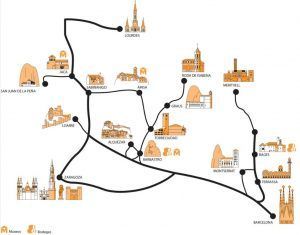The “Must See” tourist visits in the Marian Route
Going across the Marian Route and visiting its sanctuaries allows the visitor, in addition a spiritual and intimate experience, to discover a territory with a rich artistic, cultural and natural heritage.
The different attractions than can be found are cathedrals, castles, monasteries, churches, parks, landscapes & amazing scenery, gastronomy, wine cellars, or museums among others. All together makes this route a global destination with a high tourist and cultural value. Some people visit the sanctuaries as non believers. Tourist and visitors which are attracted by the artistic and architectural beauty of temples and their surrounding areas. Therefore, the Marian Route has travelling options for everyone. For those who believe and for those who do not. Travelling options that are highly recommended for everyone.
The Marian Route, valid for the believers and for the art and nature lovers, possesses an important number of ‘essential visits’ that are shown bellow. Do not miss the opportunity to visit them.
El Pilar surroundings
The Salvador Cathedral
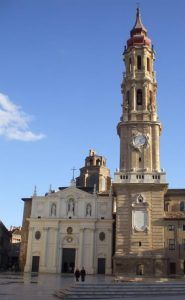
The Salvador Cathedral, as known as ‘La Seo’, is the first Christian Cathedral in Saragossa.
It was erected in the same spot where the roman temple, the Visigothic church and the main Muslim mosque were located. This wall closes the Saint Michael chapel; funerary chapel with a splendorous golden wood ceiling. The dome is another valuable example of the importance of the Mudéjar art in Aragón. The latest additions to the cathedral are the baroque tower and the classicist facade that were built in the 17th and 18th centuries.
In the interior, the altarpiece stands out. It is a representative piece of the European gothic made in the 15th century.
It is one of the UNESCO World Heritage sites.
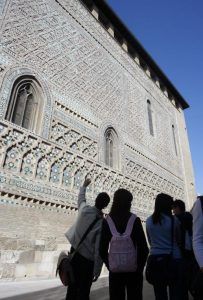 The “Parroquieta” wall is the highest expression of the Saragossa ‘mudéjar art’.
The “Parroquieta” wall is the highest expression of the Saragossa ‘mudéjar art’.
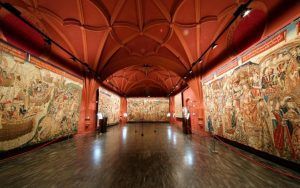 The Tapestries Museum is located inside the cathedral.
The Tapestries Museum is located inside the cathedral.
It has a valuable collection of tapestries from the 15th to the 18th centuries and it is considered one of the jewels of the Spanish historic patrimony. Due to its age and number of pieces, it is considered one of the most important collections in the world. The collection consists of 63 pieces woven by well known European textile mills of Arras, Tournai and Brussels. Most of the pieces are what they are known as the “prince edition” (first tapestry of each cardboard)
Location: Plaza de La Seo, 4, 50.001 – Zaragoza – More information about opening hours and tickets: Cathedral and Tapestries Museum
Alma Mater Museum
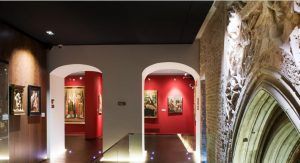
The renovated Alma Mater Museum (the old ‘Diocesan Museum’) is located in the offices of the Archbishop’s Palace. The result is a perfect joining between the historic building and the works exhibited. The visit is conceived to do with a guide, and so, along the route, the audiovisuals, the explanations and the museum publications will make the visit a great experience.
Location: Plaza de la Seo, 5 – 50001 – Zaragoza – Tph. +34 976 399 488
www.almamatermuseum – E-mail: info@almamatermuseum.com
Aljafería Palace-Castle
The Aljafería Palace is one of the UNESCO World Heritage sites. An astonishing Arabic palace located in the middle of the city. It was declared World Heritage Site due to the ‘Aragonese Mudéjar style’ that is part of its construction. This 11th century castle/palace was initially constructed as a recreation home, although later one was also used as a defensive building. It is one of the most important monuments in Spanish-Muslim architecture. It was erected as a symbol of the power gained by the Zaragoza Taifa and it was called palace of happiness. Three are the main Islamic constructions that we can see today and that were built in the Taifas kingdoms. These buildings are the Alhambra in Granada, the Cordoba Mosque and the Aljafería Palace.
It is one of the most important monuments in Spanish-Muslim architecture. It was erected as a symbol of the power gained by the Zaragoza Taifa and it was called palace of happiness. Three are the main Islamic constructions that we can see today and that were built in the Taifas kingdoms. These buildings are the Alhambra in Granada, the Cordoba Mosque and the Aljafería Palace.
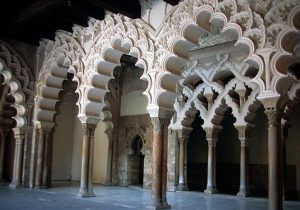
Location: C/ Diputados, s/n – Zaragoza
Schedule: Aljafería Palace
To access the palace must arrange their visit in advance by using the online program at the following link: https://reservasonline.aljaferia.com
The Roman Caesaraugusta
The city of ‘Caesar Augusta’ or ‘Caesaraugusta’ was founded around 15 b.c. This was the name that Zaragoza got on those days. It had the privilege of getting its name from the founder´s full name. The city was at its height during the 1st and 2nd centuries. This period brought many great public building works and some of those constructions can be seen today. The city walls, the river port, the forum, the public baths or the theatre.

The City Walls – Public Baths – Forum – The River Port
The Roman Caesaraugusta itinerary:
The City Walls: Zaragoza, an important centre in Roman Hispania, conserves part of the city wall. It’s located in the historical center, next to the Pilar, and it’s an interesting archaeological remains that shows the importance of the city at the time.
Public Bath Museum: In 1982-1983, during maintenance works on the streets, the remains of a large pool belonging to some Roman public baths were discovered. This find was extended in 1990 with the discovery of latrines belonging to an earlier stage. The public baths were situated in the centre of Caesaraugusta, in the area between the Forum and the Theatre.
Forum Museum: The Forum was the heart in a Roman city. It was the main meeting point where the political, administrative, economic and religious life of the city developed. This monumental site was completed by numerous ornamental elements (sacrificial altars, honorific statues and triumphal arches), some of which are represented on coins from the city.
River Port Museum: In Roman times, the River Ebro was navigable from Dertosa (Tortosa) up to Vareia (Logroño). Caesaraugusta was the main redistribution centre of the valley for merchandise from inland, as well as from the coast
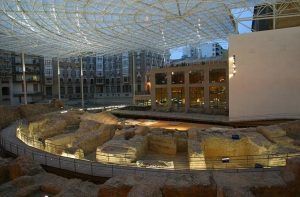 Cesaraugusta Theatre: The theatre was the most popular building in the city. Situated in a privileged urban area, building was begun in Tiberius time. Architecturally, the Caesaravgvsta theatre is an excellent example of a prototype to be found all over the Roman Mediterranean world. It is a building constructed as an arena, unlike the theatres in which the spectators seats were on the side of a hill.
Cesaraugusta Theatre: The theatre was the most popular building in the city. Situated in a privileged urban area, building was begun in Tiberius time. Architecturally, the Caesaravgvsta theatre is an excellent example of a prototype to be found all over the Roman Mediterranean world. It is a building constructed as an arena, unlike the theatres in which the spectators seats were on the side of a hill.
Locations: click here
Roman Museums information: Roman Museums of Zaragoza
Goya in Zaragoza
 The figure of the genial Aragonese painter is linked to Zaragoza. Francisco de Goya y Lucientes was born in Fuendetodos, a small village near Zaragoza. The house where he was born can still be seen in that village and it has been declared National Historic Monument.
The figure of the genial Aragonese painter is linked to Zaragoza. Francisco de Goya y Lucientes was born in Fuendetodos, a small village near Zaragoza. The house where he was born can still be seen in that village and it has been declared National Historic Monument.
Several of his paintings can be seen in Zaragoza. Some of these outstanding pieces can be found in the Basilica of the Pillar domes, as well as several engravings and portraits of distinguish noble and political figures of that age distributed among different museums in the city.
The Goya Tour will take us to the following places:
El Pilar Basilica – 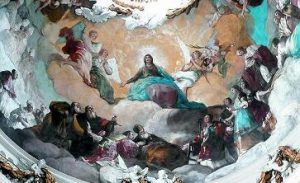 The Goya paintings that can be seen in the domes are a very valuable representation dedicated to the religious devotion. ‘La adoración del nombre de Dios’ (The worship of God´s name) is a fresco of Italian influence and soft modelling. ‘Regina Martyrum’ is however a innovating and imaginative painting, very expressive and one of the most important pieces of Goya. This fresco confirmed him as a great painter. Oddly, he got hard reviews right after finishing it.
The Goya paintings that can be seen in the domes are a very valuable representation dedicated to the religious devotion. ‘La adoración del nombre de Dios’ (The worship of God´s name) is a fresco of Italian influence and soft modelling. ‘Regina Martyrum’ is however a innovating and imaginative painting, very expressive and one of the most important pieces of Goya. This fresco confirmed him as a great painter. Oddly, he got hard reviews right after finishing it.
Zaragoza Museum – The Zaragoza Museum is one of the most recommended cultural visits in the city. The work of Goya here is extensive. We can emphasize your series of portraits painted in different moments of his career (Carlos IV, Maria Luisa of Parma, Fernando VII, the Duke of San Carlos…), pictures with religious themes and a variety of engravings.
Location: Plaza de los Sitios, 6 – Zaragoza. Monday closed. Free entrance.
Goya Museum – 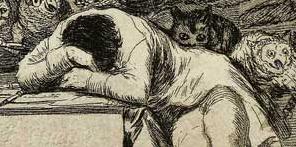 It is the only museum in the world that exposes all series of engravings of Francisco de Goya. Three floors: the first based on history of Goya; the second floor is dedicated to Goya (religious paintings, portraits and engravings of ‘Los Caprichos’, ‘Los Desastres de la guerra’, ‘La Tauromaquia’ or ‘Los Disparates’); the third is dedicated to followers and imitators of Goya.
It is the only museum in the world that exposes all series of engravings of Francisco de Goya. Three floors: the first based on history of Goya; the second floor is dedicated to Goya (religious paintings, portraits and engravings of ‘Los Caprichos’, ‘Los Desastres de la guerra’, ‘La Tauromaquia’ or ‘Los Disparates’); the third is dedicated to followers and imitators of Goya.
Location: C/ Espoz y Mina, 23 – Zaragoza – To book: Goya Museum – e-mail: museogoya@fundacionibercaja.es
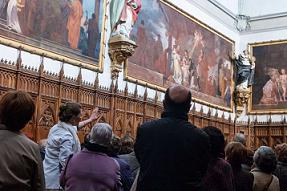
Aula Dei Monastery– Located just 15 km from Zaragoza, the Cartuja of the Aula Dei (Aula Dei Monastery) keeps one of the best and most unknown works by Francisco de Goya. It is a surprising visit, a set of 11 paintings that decorate the church of this monastery, dedicated to the Virgin Mary life.
Location: Ctra. Montaña-Peñaflor, km. 14 – To book: visitas.cartuja@chemin-neuf.org or tph. +34 976 45 00 02
Web Aula Dei Monastery
Alma Mater Museum – www.almamatermuseum.com
The Mudéjar Art in Zaragoza
This unique architecture, specific from the Aragon autonomous community, is a UNESCO World Heritage site. The term “mudéjar” comes from the Arabic word mudayyan that means “person who has been allowed to stay”.
The origin of the Mudéjar art can be placed in the 12th century. It is the result of the particular political, social and cultural conditions that the mudejars had in the Spanish Reconquest. The Mudéjar architecture is characterized by the use of bricks, plaster, ceramics or wood, as well as for the decoration based on crossing arches, geometrical compositions and vegetable like decoration.
There are many and beautiful examples of Mudéjar architecture in Zaragoza.
These are some examples:
Aljafería Palace – (click here)
San Salvador Cathedral – (click here)
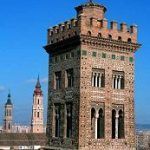 St. María Magdalena church – (click here)
St. María Magdalena church – (click here)
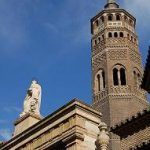 St. Pablo church – (click here)
St. Pablo church – (click here)
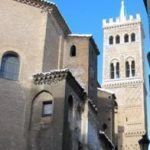 St. Gil Abad church – (click here)
St. Gil Abad church – (click here)
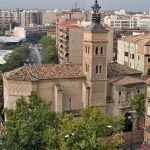 St. Miguel church – (click here)
St. Miguel church – (click here)
La Zuda tower 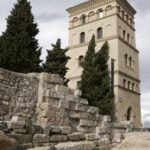 – (click here)
– (click here)
Torreciudad surroundings
- *
- Barbastro, Alquézar and Guara
- Graus - Ribagorza
- Aínsa - Sobrarbe
- Loarre
- Huesca, Jaca and Canfranc
- Ordesa-Monte Perdido Park
Torreciudad is an ideal starting point to see part of the tourist attractions located in the Aragón territory.
Region of Somontano: Barbastro, Alquézar and Guara Park
Barbastro is the capital city of the Somontano region, one of the three regions that surround the Sanctuary of Torreciudad.
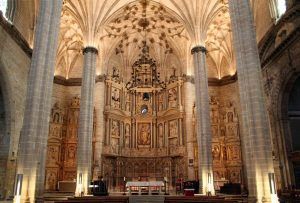 One of its main monuments is the magnificent Cathedral of la Asunción, 16th century, built on the site of the old mosque. The building was built with the purpose of re-establish for the city the category of an Episcopal See. With a Gothic appearance and a Renaissance inside design, the cathedral stands out for its large size and for its spectacular vaults. The design of the bank of the altarpiece is a work of the teacher Damiant Forment, who also performed the altarpiece from the ‘Basilica del Pilar’. The Cathedral of Barbastro is at the same level of the best churches.
One of its main monuments is the magnificent Cathedral of la Asunción, 16th century, built on the site of the old mosque. The building was built with the purpose of re-establish for the city the category of an Episcopal See. With a Gothic appearance and a Renaissance inside design, the cathedral stands out for its large size and for its spectacular vaults. The design of the bank of the altarpiece is a work of the teacher Damiant Forment, who also performed the altarpiece from the ‘Basilica del Pilar’. The Cathedral of Barbastro is at the same level of the best churches.
Next to the Cathedral is the Episcopal Palace which harbours the Diocesan Museum.
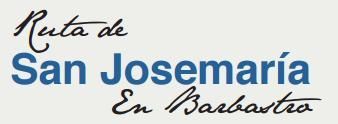 Barbastro is the capital of the wine (Somontano region). The Wine Route is part of the tourist routes collected by the General Secretariat of Tourism of Spain. The visitor will be able to know different wineries and tourist establishments that will help him understand the local wine culture and local cuisine. The visit to Barbastro is completed with a walk for the old town, the Museum of the Claretian Martyrs and The Route of St. Josemaría. The founder of the Opus Dei and promoter of the construction of the Shrine of Torreciudad was born in Barbastro and is here where you can meet a series of relevant places in the life of St. Josemaría.
Barbastro is the capital of the wine (Somontano region). The Wine Route is part of the tourist routes collected by the General Secretariat of Tourism of Spain. The visitor will be able to know different wineries and tourist establishments that will help him understand the local wine culture and local cuisine. The visit to Barbastro is completed with a walk for the old town, the Museum of the Claretian Martyrs and The Route of St. Josemaría. The founder of the Opus Dei and promoter of the construction of the Shrine of Torreciudad was born in Barbastro and is here where you can meet a series of relevant places in the life of St. Josemaría.
More information: Tourism of Somontano (click here).
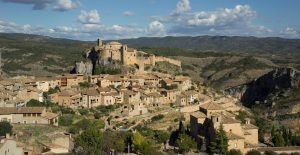
The medieval village of Alquézar
Near to Barbastro we find Alquézar, a beautiful village that offers a medieval urban area declared Historic and Artistic Site. It has the spectacular Santa Maria la Mayor Collegiate-castle and the medieval labyrinth like streets. The Somontano territory mixes perfectly the cultural patrimony with the natural spaces. From this part, stands out the Natural Park of the Sierra y Cañones de Guara. This park constitutes a gift of the Nature, the place with the most spectacular ravines and canyons in Europe. The union of the rock, the water and the passage of time have made Guara the leading destination in water adventure sports and in the practice of the descent of ravines. A large number of adventure companies are located in the area…
More information in Tourism of Aragón.
Graus and Ribagorza. Romanesque art and landscapes.
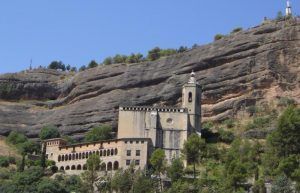 Ribagorza is the region where is located the Sanctuary of Torreciudad. The Ribagorza shire is a land full of landscaping contrasts and beautiful Romanesque churches. Near Torreciudad is Graus. The historic area of this village was declared Historic and Artistic Site. It has one of the most beautiful butter walked squares of the Spain, the Plaza Mayor. The style of the buildings, very close to the Italian Renaissance, made it become the location set for commercials that tried to recreate that country.
Ribagorza is the region where is located the Sanctuary of Torreciudad. The Ribagorza shire is a land full of landscaping contrasts and beautiful Romanesque churches. Near Torreciudad is Graus. The historic area of this village was declared Historic and Artistic Site. It has one of the most beautiful butter walked squares of the Spain, the Plaza Mayor. The style of the buildings, very close to the Italian Renaissance, made it become the location set for commercials that tried to recreate that country.
But the most important building is the basilica of the ‘Virgen de la Peña’, the monument most visited. From this basilica you can give a magnificent view of the Graus.
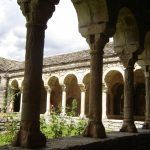 Another jewel of this area is Roda de Isábena, a lovely medieval village. A visit to this village will take you to the spectacular Romanesque cathedral of San Vicente (11th to 13th centuries). The little cloister of the cathedral is a wonder place.
Another jewel of this area is Roda de Isábena, a lovely medieval village. A visit to this village will take you to the spectacular Romanesque cathedral of San Vicente (11th to 13th centuries). The little cloister of the cathedral is a wonder place.
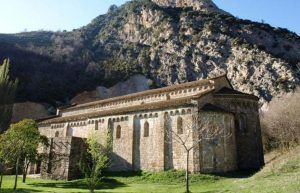
One of the best examples of Lombard Romanesque art of the High Aragon is the Obarra Monastery (9th century). The church of the old monastery is one of the most important and primitive Romanesque construction of all the Spanish patrimony. As a natural space, the Posets Maladeta Natural Park offers a wide variety of activities for all kind of people. More information in Tourism of Aragón.
Aínsa and Sobrarbe. The Pineta Valley.
Just after leaving Torreciudad, you will find the small village of Abizanda. It will surprise you due to its skyline shaped by the silhouette of the fortress. It is remarkable the strong Romanesque tower built by Lombard masters. The view from the top will allow you to contemplate the beauty of the shire and the Pyrenees.
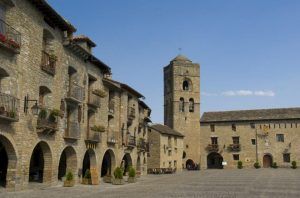 Continuing with the trip, you will arrive to Aínsa, capital of the Sobrarbe region, one of the most beautiful medieval villages in Spain. It has been declared Historic and Artistic Site. The walls that surround the village, as well as its historic side are extremely well preserved. The castle, the cathedral and the square stand out in the monumental area. For a better experience exploring the village, you should walk the streets and squares, eat at a restaurant and let yourself go with the enchantment found in every corner.
Continuing with the trip, you will arrive to Aínsa, capital of the Sobrarbe region, one of the most beautiful medieval villages in Spain. It has been declared Historic and Artistic Site. The walls that surround the village, as well as its historic side are extremely well preserved. The castle, the cathedral and the square stand out in the monumental area. For a better experience exploring the village, you should walk the streets and squares, eat at a restaurant and let yourself go with the enchantment found in every corner.
Close to the border, we arrived to Bielsa, place of departure of countless tours through the valley of Pineta. This town is famous for its Carnival, one of the oldest and most tradition in the Pyrenees.
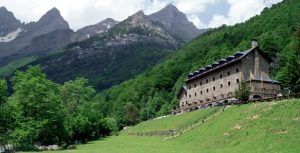 The Pineta Valley is the north east side of the Ordesa and Monte Perdido National Park and one of the most wild but attractive valleys. If you have time, we recommend a visit to the open area where the image of “Virgin of Pineta”, near to the Parador (hotel). This tour goes through a beautiful road with a superb scenery.
The Pineta Valley is the north east side of the Ordesa and Monte Perdido National Park and one of the most wild but attractive valleys. If you have time, we recommend a visit to the open area where the image of “Virgin of Pineta”, near to the Parador (hotel). This tour goes through a beautiful road with a superb scenery.
More information in Tourism of Aragón.
Loarre Castle
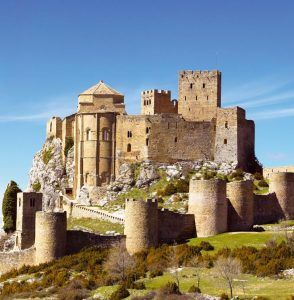 Located near Huesca, the Loarre Castle is the masterpiece of the Romanesque fortifications in the 11th century. It is preserved in amazing condition. This medieval castle is considered one of the best military and civil architecture constructions that can be seen nowadays in Europe. The castle can be visited with guided tour. His image is so remarkable that several directors have chosen this fortification as setting for their films, the most famous ‘Kingdom of heaven’, by Ridley Scott.
Located near Huesca, the Loarre Castle is the masterpiece of the Romanesque fortifications in the 11th century. It is preserved in amazing condition. This medieval castle is considered one of the best military and civil architecture constructions that can be seen nowadays in Europe. The castle can be visited with guided tour. His image is so remarkable that several directors have chosen this fortification as setting for their films, the most famous ‘Kingdom of heaven’, by Ridley Scott.
More information in Tourism of Aragón.
To the Aragón Valley by Huesca, Jaca and Canfranc
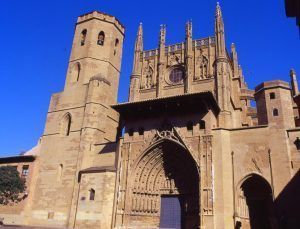 Huesca is a very hospitable town. It is worth taking a look at the historic quarter. The Cathedral and the San Pedro el Viejo church are almost mandatory stops. The Church of San Pedro el Viejo, declared as National Monument in 1885, is a simple and beautiful example of Romanesque architecture of Aragon and one of the jewels of the monumental heritage of the city. Its cloister, one of the most beautiful, is Royal Pantheon, the place where are the remains of the kings Alfonso I ‘the Warrior’ and Ramiro II ‘the Monk’.
Huesca is a very hospitable town. It is worth taking a look at the historic quarter. The Cathedral and the San Pedro el Viejo church are almost mandatory stops. The Church of San Pedro el Viejo, declared as National Monument in 1885, is a simple and beautiful example of Romanesque architecture of Aragon and one of the jewels of the monumental heritage of the city. Its cloister, one of the most beautiful, is Royal Pantheon, the place where are the remains of the kings Alfonso I ‘the Warrior’ and Ramiro II ‘the Monk’.
The Cathedral is a magnificent gothic temple. On the external you can appreciate a splendid decoration. The High Altar is the wonderful piece of Damian Forment, representing the Passion of Christ. Next to the Cathedral is the Diocesan Museum, which offers genuine wonders of sacred art in its various rooms of jewellery, art, medieval, renaissance and baroque.
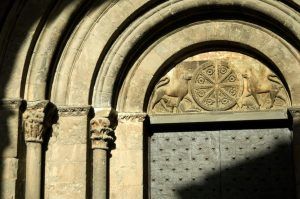
Jaca is an important tourist center and winter sports with a great historical and monumental patrimony. It has a jewel of Spanish Romanesque, the Cathedral of San Pedro. Dated in the 11th century, this building constitutes one of the most important artistic treasures of Aragon and the peninsula. It was the first great Romanesque construction in Spain. The cathedral of Jaca is admired by its rich and varied sculptural decoration on capitals, walls and bases. In this aspect, it is necessary to emphasize the known ‘ajedrezado jaques’, a type of ornamentation that simulates a chess board. The cathedral welcomes from 1963 a Diocesan museum with a permanent exhibition of artistic funds of the diocese.
Almost on the border with France we arrive at Canfranc, before an important town in the national territory due to its strategic border location. Here we can see one of the most beautiful and impressive railway stations in Spain, inaugurated by the Alfonso XIII king in 1928, an authentic beauty architectural building of this time.
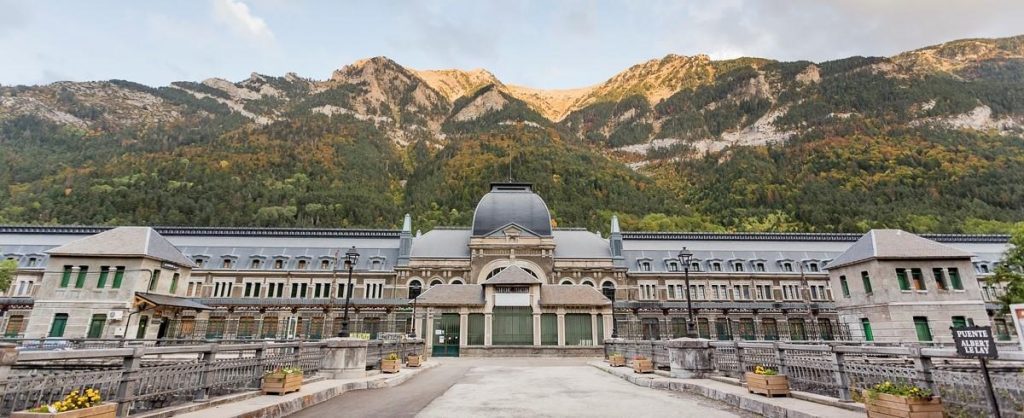
Inspired by the French palaces, the Canfranc International Railway Station is a really great station, not only for its size and shapes but for the environment where is located, at almost 1,200 meters of altitude. Many years ago, it received travellers who came to Spain with a luxury hotel, casino, customs … Until the Second World War, it lived moments of splendour as an international border station with France, but its decline being with the Nazi occupation that used it as a store to save the gold that they had caught by different countries in Europe. Closed to the traffic in 1945 due to political disagreements with the French government, its modernist and art deco style has been claimed for the filming of several advertisements and films, and today, completely renovated, it shows again all the original splendour converted into a luxury hotel five stars.
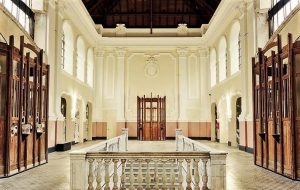 The historic lobby is shared by hotel guests, visitors, curious and travellers due to it works as a station for regional/national trains, waiting for the future the opening of new international routes with France. Guided tours can be taken to discover the fascinating history of this legendary border station, learning about the underpass, the majestic lobby and the incredible stories that taken place here during the World War II.
The historic lobby is shared by hotel guests, visitors, curious and travellers due to it works as a station for regional/national trains, waiting for the future the opening of new international routes with France. Guided tours can be taken to discover the fascinating history of this legendary border station, learning about the underpass, the majestic lobby and the incredible stories that taken place here during the World War II.
More information in Tourism of Aragón.
The Ordesa and Monte Perdido National Park
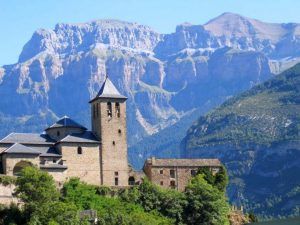 The Pyrenees villages of Boltaña, Fiscal, Broto and Torla take us to the entrance of a true natural beauty of the Aragonese Pyrenees: the Ordesa and Monte Perdido National Park. The highest mountain is Monte Perdido (11,007 feet) and the main valley is the Ordesa Valley as it is the main entrance to the park too. Several excursions of different difficulties will make possible the enjoyment of the greatness of this Natural beauty, the green valleys, forests, meadows, waterfalls and ravines. In 1997 got the highest award from the UNESCO as it was declared World Heritage together with the glaciers of the French side.
The Pyrenees villages of Boltaña, Fiscal, Broto and Torla take us to the entrance of a true natural beauty of the Aragonese Pyrenees: the Ordesa and Monte Perdido National Park. The highest mountain is Monte Perdido (11,007 feet) and the main valley is the Ordesa Valley as it is the main entrance to the park too. Several excursions of different difficulties will make possible the enjoyment of the greatness of this Natural beauty, the green valleys, forests, meadows, waterfalls and ravines. In 1997 got the highest award from the UNESCO as it was declared World Heritage together with the glaciers of the French side.
Más información en Turismo de Aragón
Montserrat surroundings
The Sanctuary of Montserrat, set deep in a idyllic natural environment, is a place full of history, legend an culture.
The Montserrat Mountain Natural Park
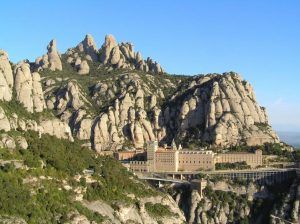 The Montserrat Mountain Natural Park is a unique mountain formation in the world, due to the particular and spectacular forms. The mountain was officially declared Natural Park in 1987 to guarantee its preservation. The word “Montserrat” comes from the Catalonian words “Mont” (mount) and “serrat” (serrated). Therefore, the meaning of the word is “the serrated mount”. The name is given due to the peculiar morphology of the mountain, as it looks like if the mountain was serrated. Throughout the time, the wind and the rain have been shaping the rocks, giving them very diverse forms.
The Montserrat Mountain Natural Park is a unique mountain formation in the world, due to the particular and spectacular forms. The mountain was officially declared Natural Park in 1987 to guarantee its preservation. The word “Montserrat” comes from the Catalonian words “Mont” (mount) and “serrat” (serrated). Therefore, the meaning of the word is “the serrated mount”. The name is given due to the peculiar morphology of the mountain, as it looks like if the mountain was serrated. Throughout the time, the wind and the rain have been shaping the rocks, giving them very diverse forms.
Information Office: Tph. +34 93 877 77 77 – informacio@larsa-montserrat.com – www.montserratvisita.com
The Museum
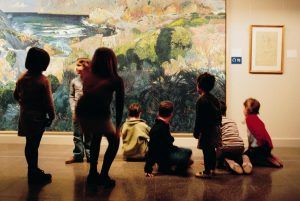 The Montserrat Museum is without question, one of the great exposition spaces in both Catalonia and Spain. It keeps more than 1,300 pieces of art from an extensive chronologic period. Some of those pieces are from artists as important as Picasso, Dalí or El Greco. The majority of the pieces in exhibition come from private donations. These donations were made with the purpose of making the art available for all visitors to the sanctuary. The monastery carries out those wishes continuing with the spirit of cultural service.
The Montserrat Museum is without question, one of the great exposition spaces in both Catalonia and Spain. It keeps more than 1,300 pieces of art from an extensive chronologic period. Some of those pieces are from artists as important as Picasso, Dalí or El Greco. The majority of the pieces in exhibition come from private donations. These donations were made with the purpose of making the art available for all visitors to the sanctuary. The monastery carries out those wishes continuing with the spirit of cultural service.
There are five permanent collections on exhibition:
- Orient Biblical Archaeology: objects representing the cultures of Mesopotamia, Egypt, Cyprus and Palestine.
- Paintings from the 13th to 18th centuries: Luca Giordano, A. Vaccaro, Tiepolo, Berruguete, Caravaggio, El Greco, Morales…
- Iconography dedicated to the ‘Virgin of Saint Mary of Montserrat’
- Religious gold/silver works
- Modern paintings and sculptures from the 19th to the 20th centuries. It includes pieces of artists such as Dalí, Monet, Sisley, Degas, Pissarro, Chagall, Le Corbusier, Miró, Picasso or Tápies among others.
Opening hours: from Monday to Sunday: from 10.00 to 17.45 h.
More information: informacio@larsa-montserrat.com – Tph.: +34 93 877 77 77
The Montserrat funiculars
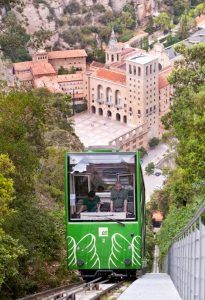 On one side, the Saint Joan funicular that at 3000 feet offers a bird´s eye view of the sanctuary. On the Saint Joan top station, the tourist can visit the Nature Classroom where we will find information about the history of the mountain, the climatic characteristics… many excursions start from this top point.
On one side, the Saint Joan funicular that at 3000 feet offers a bird´s eye view of the sanctuary. On the Saint Joan top station, the tourist can visit the Nature Classroom where we will find information about the history of the mountain, the climatic characteristics… many excursions start from this top point.
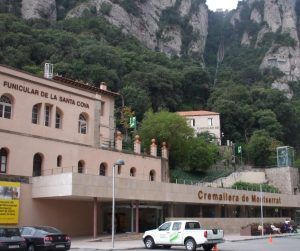 On the other side, the Santa Cova funicular links the sanctuary with
On the other side, the Santa Cova funicular links the sanctuary with
the cave in the rock where, according to the legend, some shepherds
found the image of the Virgin of Montserrat. The funicular arrives to
the place where the Monumental Rosary begins. This rosary is the
most important open air sculpture set of the Catalonian modernism.
Pieces of Antonio Gaudi, Josep Llimona and other authors are part of it.
More information: from 9 to 19.45 h. Tph.: 93 877 77 77 – informacio@larsa-montserrat.com
Itineraries from the monastery
Itinerary 1.- Monastery-Los Degollados-Monastery 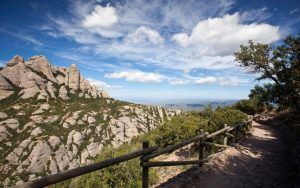
Slope: 15 m. – Length: 3,20 km. – Estimated time: 50 min. – Difficulty: Very easy
This path, in a shady area facing north-east, is flanked by holm-oaks, typical of Mediterranean climate. Its undergrowth consists of bushes such as laurestine, holly or butcher’s broom. It is a peaceful path that invites to recollection, decorated with monuments dedicated to artists and maiolicas that evoke numerous Marian devotions. Follow the main street towards the car park. When you get to the building Mirador dels Apòstols, take the path that starts on the left side, which runs in parallel with the road. After 25 min. you will get to the rock shelter Degotalls where, in former days, filtered water dripped from the rocks. You must then return the same way.
Itinerary 2.- Monastery-Santa Cueva (Holy Grotto)-Monastery
Slope: 125 m. – Length: 2,70 km. – Estimated time: 1h. 30 min. – Difficulty: Easy
Tradition sets the finding of Our Lady of Montserrat in the place known as Santa Cueva (Holy Grotto). The chapel dates from the 18th century. It’s remarkable the monumental ensemble with the mysteries of the Rosary standing along the path. Head towards the cable car station (Aeri de Montserrat), walking down the stairs on the left side of the rack railway station (Cremallera). Take the paved path that descends between the station and the rack railway tracks and, in 20 min., you will get to the lower station of Santa Cueva funicular. Follow then the way of the Rosary, wide and flanked by monuments which recall events in the lives of Jesus and Mary. It will take you another 20 min. to get to Santa Cueva’s chapel. Return using the same path.
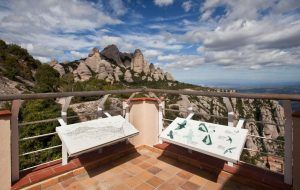 Itinerary 3.- Sant Joan funicular’s upper station – Sant Jeroni – Pla dels Ocells – Monastery
Itinerary 3.- Sant Joan funicular’s upper station – Sant Jeroni – Pla dels Ocells – Monastery
Slope: 524 m. – Length: 7,50 km. – Estimated time: 2h. 30 min. – Difficulty: Medium
A hike of exceptional interest up to Montserrat’s summit, with spectacular views over the massif, and great part of Catalonia. Take Sant Joan funicular one-way and, right after getting out of the upper station, turn right and follow the signposted path. After a few metres, when the path turns left, you will be able to gaze at the pinnacles known as the Pregnant Woman, the Elephant, the Mummy and the Little Mummy. After 12 min from the start you will get to the foot of the Phrygian Cap, a peculiar pinnacle crowned with a cross. If you look down from the handrail you can see the Monastery. After a passage between two rocks, there is a vantage point on your left. The path, slightly uphill, enters the forest, and crosses the Santa Maria stream (35 min.) through a wooden walkway. After this, you must continue uphill towards a paved path. On your right, you should be able to identify the path you are going to use on your way back to the Monastery. After this you will get to Sant Jeroni’s hermitage (60 min.), where the path splits. Turn left, uphill, and within 10 minutes you will get to the summit, Sant Jeroni (1236 m.). An orientation table allows you to identify the surrounding mountainous relief, from the Pyrenees to the Ports and Majorca. You will then return the same way until the signposted crossroad by the paved path (1 h. 30 min.), taking the path on our left that zigzags down to Pla dels Ocells (2 h.). Here you must take the path towards the Monastery. You will go past Panxa del Bisbe (The Bishop’s Belly) and then start a long descent downstairs, through Pas dels Francesos (Passage of the French) until the Monastery.
Itinerary 4.- Sant Joan funicular’s upper station – Way of les Ermites – Santa Cueva (Holy Grotto) – Monastery
Slope: 375 m. – Length: 5,20 km. – Estimated time: 1h. 50 min. – Difficulty: Medium
A hike on the southern slope, on uneven terrain, often stony. It connects with hike 2 to Santa Cueva.
Take Sant Joan funicular one-way and, once on the upper station, take the wide, paved path on the left that climbs up to a hill. Once there, the path climbs slightly down towards Pla de Sant Miquel (20 min.), where you reach a crossroad. You must take the path to Santa Cova and, shortly after, the path turns sharply. From here you will enjoy a beautiful view of river Llobregat and the ranges Sant Salvador, Puigventós, Sant Llorenç and the Montseny (35 min.). Within 45 min. you will get to a crossroad. Leave the red and white long-distance trail signs on your right, and follow the path on the left that will take you to Santa Cueva (Holy Grotto)(1h.). From here it becomes a paved path, with a strong, upward slope in the last part. Arrival at the monastery (1 h. 50 min.).
Itinerary 5.- Sant Joan funicular’s upper station – Way of la Font Seca – Way of les Bateries – Monastery
Slope: 250 m. – Length: 5,20 km. – Estimated time: 1h. 45min. – Difficulty: Medium
A hike on Montserrat’s southern slope, through the ancient road from Collbató to Montserrat. Cannon batteries were placed at strategic points along the path during the Peninsular War (beginning of 19th century), which gave the name ‘Batteries’ to this path. Mediterranean, aromatic plants predominate. Take Sant Joan funicular one-way and, right after getting out of the upper station, take the signposted path towards Sant Joan hermitage. You will go past the pinnacle called Gorra Marinera (Sailor’s cap)(8 min.). After a few metres, you will find a little trail on the left towards Collbató through the stream of Font Seca (Dried up Fountain) (11 min.), where you will start the descent.
This path connects with the way of Bateries, which you will follow slightly uphill towards the left (35 min.). You will then reach Pla de Sant Miquel, where you must continue straight ahead towards Sant Miquel hermitage, clearly visible from here (1 h. 20 min.). Further on, you have the option of deviating from the main path to turn left to the Cross of Sant Miquel, with an impressive view of the Monastery. Back from the cross, you must retake the main path towards the Monastery through the holm-oak forest (1 h. 45 min.).
RULES AND RECOMMENDATIONS:
• Montserrat’s topography is complicated. We are often faced with walls hardly visible from the top. Do not stray from the marked paths and, if you get lost, go back to the last known position, even if it means walking up. • Montserrat has few springs. You must carry water with you. • No fires must be lit in the Nature Park • The capture and collection of animals, rocks, minerals or plants is forbidden. • Always use bins or take away any kind of rubbish.
More information, from Monday to Friday, from 9 to 18.45 h. – Week-end and holidays, from 9 to 19.45 h.
Tph.: 93 877 77 77 – informacio@larsa-montserrat.com
Lourdes surroundings
The Marian City has the attractions that must be visited during your stay. Exploring Lourdes…
The Castle-Fort of Lourdes
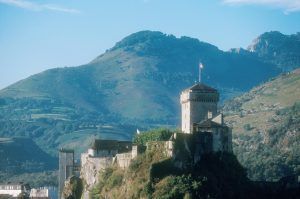 Magnificent example of a Pyrenees fortress overlooking the city, which has never been conquered. It was declared Historic Monument and so it’s a listed historical monument and a museum of France. This site offers exceptional views of the city, the Sanctuaries and the Pyrenees.
Magnificent example of a Pyrenees fortress overlooking the city, which has never been conquered. It was declared Historic Monument and so it’s a listed historical monument and a museum of France. This site offers exceptional views of the city, the Sanctuaries and the Pyrenees.
The Pyrenees Museum is located inside and has one of the most important collections about the history of these mountains.
Peak of the Jer (Pic du Jer)
It overlooks the entire city and it is easily recognizable by the big cross that is lit when the night falls. Getting to the summit can be done using the funicular that offers the passengers incredible views. At the top, you have the best view: the Pyrenees, Lourdes, Pau and Tarbes can be seen.

The Pyrenees National Park
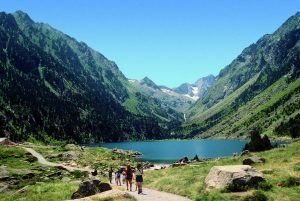 Located just 19 miles from Lourdes, the Pyrenees National Park is the great French Pyrenees Natural space. The union of six big valleys shapes this wide territory. This is the heart of the Park: astride the French-Spanish border, is the massif of Monte Perdido that rises over 3,000m in altitude. To the south are the extraordinary canyons of Ordesa, Añisclo and Pineta. To their north, the land of cirques with the majestic Gavarnie. All this ensemble (two parks in true) are what is known as the Gavarnie-Monte Perdido Massif that was declared World Heritage by the UNESCO in 1997 and under de denomination “Pyrenees Monte Perdido cirques and canyons” for both natural and cultural reasons.
Located just 19 miles from Lourdes, the Pyrenees National Park is the great French Pyrenees Natural space. The union of six big valleys shapes this wide territory. This is the heart of the Park: astride the French-Spanish border, is the massif of Monte Perdido that rises over 3,000m in altitude. To the south are the extraordinary canyons of Ordesa, Añisclo and Pineta. To their north, the land of cirques with the majestic Gavarnie. All this ensemble (two parks in true) are what is known as the Gavarnie-Monte Perdido Massif that was declared World Heritage by the UNESCO in 1997 and under de denomination “Pyrenees Monte Perdido cirques and canyons” for both natural and cultural reasons.
Besides, the Pic du Midi de Bigorre and the Pont d’Espagne offer different spectacular views and a exceptional wildlife.
The Bétharram Coves
 The coves offer a fantastic tour through stalactites, stalagmites, calcites and marmites. Most of this tour is done onboard a boat and through interior channels. Five levels stacked on top of each other like storeys of a house, with the levels having been hollowed out at different times.
The coves offer a fantastic tour through stalactites, stalagmites, calcites and marmites. Most of this tour is done onboard a boat and through interior channels. Five levels stacked on top of each other like storeys of a house, with the levels having been hollowed out at different times.
Meritxell surroundings
La Casa de la Vall (The House of the Valley)
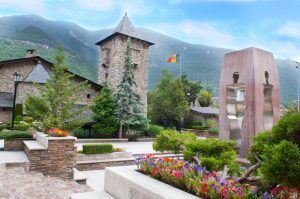 The Casa de Vall can be found in the old district. It is a building of great dimensions that was built in 1580, one of the most symbolic monuments in the Principality together with Meritxell. It was constructed under the style of the big Catalonian ‘masías’ and it was the main office of the General Council (Parliament of Andorra) until 2012 (another building was erected aside from Casa de Vall as new main office).
The Casa de Vall can be found in the old district. It is a building of great dimensions that was built in 1580, one of the most symbolic monuments in the Principality together with Meritxell. It was constructed under the style of the big Catalonian ‘masías’ and it was the main office of the General Council (Parliament of Andorra) until 2012 (another building was erected aside from Casa de Vall as new main office).
History, beauty, political importance…The visitor have lots of reasons to visit this monument so important for the country.
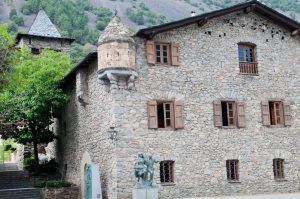 The guided visit of the interior of the building allows going around the different rooms and halls (the spectacular Criminal Court, the Hall of Lost Steps, paintings to the 16th century…), as well as the gardens. To visit it, you’ll need to buy a ticket.
The guided visit of the interior of the building allows going around the different rooms and halls (the spectacular Criminal Court, the Hall of Lost Steps, paintings to the 16th century…), as well as the gardens. To visit it, you’ll need to buy a ticket.
Location: Carrer de la Vall, s/n
More information: Official Website Casa de la Vall
Andorra Tourist Information: Tph. +(+376) 750 100 or info@oficinaturisme.ad
www.visitandorra.com
The Romanesque Art in Andorra
Andorra is in a border territory. It is a crossing point for roads and paths that communicate north and south Europe. Over the centuries and this geographic location made possible a series of mixtures and artistic and social fusions (local and foreign) that later on materialized in something more specific. The Andorran Pre-Romanesque and Romanesque art, one of the emblems of the country, is one of those high value manifestations.
The different churches and architectonic constructions that can be visited throughout the principality are a privileged way to understand the history and culture the country. The Andorran Romanesque art takes us beyond the building itself; it somehow connect us with the old religious communities, with the community past time centers of the spiritual and social life.
We can find more than forty Romanesque churches In the Andorran valleys. From an architectonic point of view, these churches are characterized for being simple constructions. They had small dimensions and bare decoration. However, they transmit beauty and spirituality without limits.
The examples that can be mentioned are innumerable, we suggest the following:
- St. Joan de Caselles, near the Sanctuary of Meritxell. It is a construction considered one of most important of the Romanesque Art in the principality. It keeps an image of Christ made in stucco that is unique in the world (12th century).
- Sanctuary of Canòlich, one of the most venerated hermitages. Its remote location kept the fervour intact from the past times.
- St. Martí de la Cortinada, Romanesque church of the 12th century. There, the visitor can admire murals painted at the end of the 12th century, as well as other interesting pieces.
- St. Coloma church, is a beautiful example which main attraction is the circular bell tower of Lombardic Romanesque style. This bell tower, unique in Andorra, is at the same time one of the few still standing with these characteristics in the Pyrenees.

St. Joan de Caselles – Sanctuary of Canòlich – St. Martí de la Cortinada – Santa Coloma church
There are many churches that could be added to complete a visit. Some examples are:
– St. Esteve church, with a Romanesque origin, but modified later on
– St. Climent de Pal church (La Massana)
– St. Cerni de Nagol church (Sant Juliá)
– St. Eulalia chuch (Encamp), with the tallest bell tower in Andorra
– St. Miquel d’Engolasters church (in Escaldes-Engordany) with a Romanesque altar piece that is worth a visit
More information in Andorra Tourist Information:
Tph. + (376) 750 100
info@oficinaturisme.ad
www.visitandorra.com
The Country of the Pyrenees
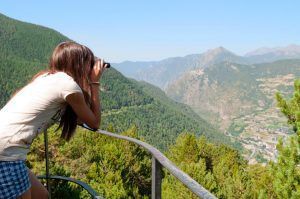 Nature is another one of the great emblems of this country. Andorra is the ‘Country of the Pyrenees’, it is nature at its best, in pure state. Landscapes formed by mountains, rivers, lakes, forests, springs, meadows… are usually found all over the place. Knowing that these elements are present, it is easy to presume the spectacularity and splendour of these lands.
Nature is another one of the great emblems of this country. Andorra is the ‘Country of the Pyrenees’, it is nature at its best, in pure state. Landscapes formed by mountains, rivers, lakes, forests, springs, meadows… are usually found all over the place. Knowing that these elements are present, it is easy to presume the spectacularity and splendour of these lands.
Andorra has more than 70 lakes and more than 80 peaks that overpass the 2,000 meters of height. Lakes are very important elements of the principality landscaping wealth. This allows the visitor the enjoyment of wonderful landscapes. Due to this, the beauty enhanced by these mountain Lakes becomes an attractive not easy to be found in other places.
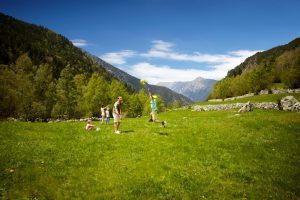 So, Andorra is a great natural theatre that possesses unique locations. As part of this magnificent patrimony, there are three protected areas of great beauty and value:
So, Andorra is a great natural theatre that possesses unique locations. As part of this magnificent patrimony, there are three protected areas of great beauty and value:
– the Valley of the Madriu-Perafita-Claror, was declared World Heritage by UNESCO in 2004 in the category of Cultural Landscape due to its beauty and its historical and cultural value.
– the Natural Park of Sorteny, with great interest due to its beauty and recreational value.
– the Natural Park of Comapedrosa. Here you can find the highest peak in the country (2,942 meters above the sea level). The main attractions of this space are: the impressive high mountain landscape, as well as the lakes, waterfalls and springs.
More information in Andorra Tourist Information:
Tph. + (376) 750 100
info@oficinaturisme.ad
www.visitandorra.com
To get away in Andorra
Andorra is a beautiful destination where you can enjoy of Meritxell, the great discovery of the Marian Route, of his nature and culture through the Romanesque churches, historic buildings and museums. But, when these main objectives are satisfied, we encourage you to keep in mind the great proposal of leisure, relaxation and entertainment that Andorra offer. There are many activities related to the sport, fun, spa…
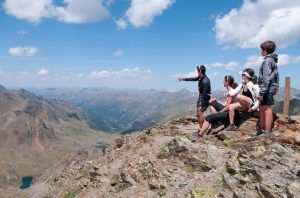 Andorra is a snow paradise. Sports, beautiful sceneries, fun and entertainment are characteristic associated to snow. The snow-covered landscapes, the Romanesque churches with white roofs, the spectacular white mountains are postcards that are difficult to find anywhere else. For those wishing to complete the visit of the Sanctuary of Meritxell with some adventure, the Grandvalira and Vallnord ski resorts offer 310 km of tracks to enjoy ski and other snow sports (the largest in Europe).
Andorra is a snow paradise. Sports, beautiful sceneries, fun and entertainment are characteristic associated to snow. The snow-covered landscapes, the Romanesque churches with white roofs, the spectacular white mountains are postcards that are difficult to find anywhere else. For those wishing to complete the visit of the Sanctuary of Meritxell with some adventure, the Grandvalira and Vallnord ski resorts offer 310 km of tracks to enjoy ski and other snow sports (the largest in Europe).
During the summer, the ski resorts become an authentic nature amusement park. A wide range of activities are available in this great natural stage.
Mountain bike excursions, quads, hiking routes or long walks allow the enjoyment of nature in all its versions. Older and young will be able to enjoy these leisure and entertainment options.
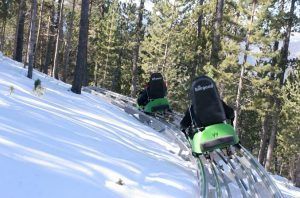
Tobotronc
Located in Sant Juliá is Naturlandia. It is an educational & adventure amusement park, where adults and young learn (while playing) about the wild life and about the typical vegetation of the Pyrenees. The Naturlandia Animal Park is marketed specially for younger kids and families. Located at 2,000 meters above the sea level, it allows the observation of brown bears, wolves, fallow deer, red deer and groundhogs. In Naturlandia, the visitor can also enjoy other activities such as the electric quads for kids or archery. Adults have also interesting activities such as zip wires, the airtrekk or the impressive ride called ‘Tobotronc’. It is the longest alpine slide in the world that runs through the forest.
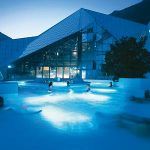
Caldea and Innu
This offer is completed with the Caldea e Inúu Thermal Water Complex (located in the business center of Escaldes-Engordany), a place thought for relaxation and to enjoy the water. The thermal waters that appear to 70ºC, are special by their properties and contribute to the body benefits, helping to the rest and to recover the vitality and the well-being. The complex has large indoor and outdoor lagoon, as well as several other elements such as jacuzzis, waterfalls, water massages areas, etc. An area of Hindu-Roman baths with temperature difference water areas and a wellness area should be added to it.
More information in Andorra Tourist Information:
Tph. + (376) 750 100
info@oficinaturisme.ad
www.visitandorra.com

The APRM is an association non profit constituted by the shrines of Pilar, Torreciudad, Meritxell, Montserrat and Lourdes whose general purpose is the promotion of this Marian Route, its sanctuaries and the historical, artistic and natural ensembles of the regions where they are located.
C/ Cádiz 12
50004 – Zaragoza (Spain)
+34 976 794 225
Web financed by:

Cooperate:

.

